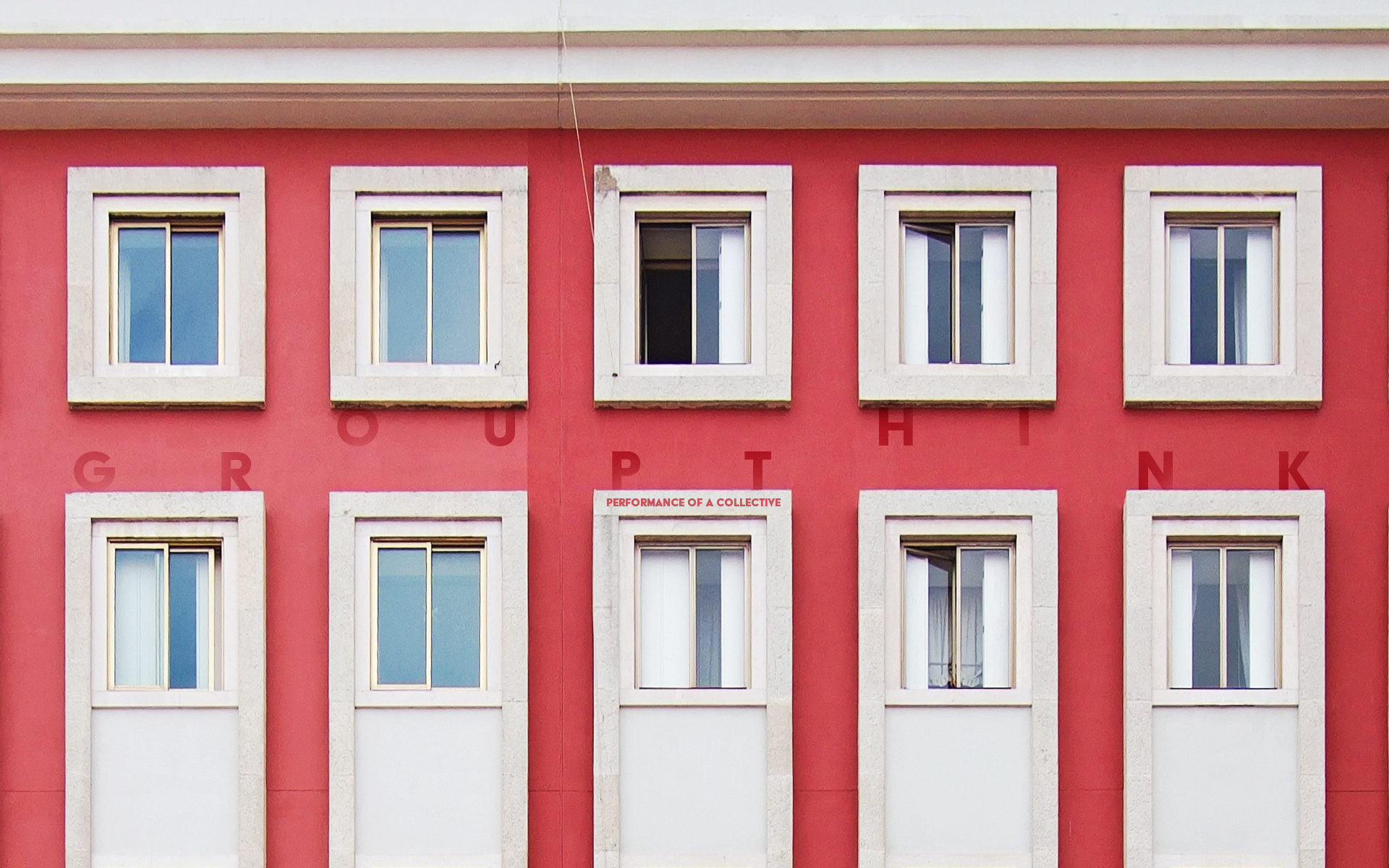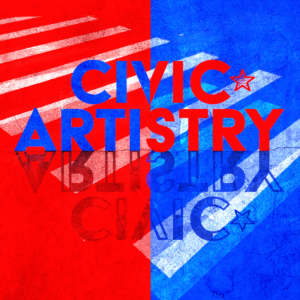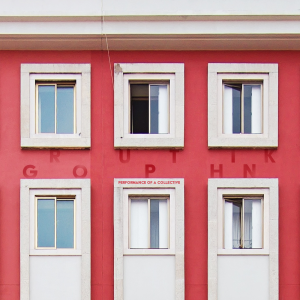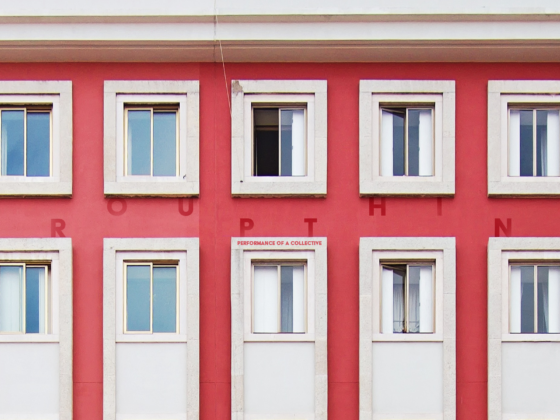SWEDIAN LIE

In this issue, we sat down with Caitlin Cassidy and Geoff Kanick, the co-artistic directors of LubDub Theatre Company, a physical theatre company based in New York City. We talked about LubDub’s unique approach to collaborative theatre-making and commitment to creating an inclusive immersive experience for the audience, in particular with their latest production, The Doubtful Guest — a play about American spiritualism, personal histories & memories, and the question, “What does it mean to be a host?” — which was directed by Caitlin and featured Geoff as one of its performers.
Hi Caitlin and Geoff, thanks for making the time to do this interview!
Can you explain what LubDub’s style and ethos of theatre are?
Caitlin Cassidy
LubDub is a physical theatre company and there are always a million questions about what exactly that means. I think for us, it means that we are as focused in our process on the physical life of the story, as we are on the textual. We work primarily with folks who are from movement backgrounds, [so] a lot of dancers, a lot of “physical theatre artists,” a lot of folks from the circus, [and] from other movement disciplines.
Geoff Kanick
And I think the other exciting piece too, that we really embrace, is the idea of mixing disciplines and doing a lot of interdisciplinary work and we’re excited about what happens when those worlds collide, or are thrown in a blender, or are shuffled around.
Caitlin Cassidy
Our work is devised and we work very closely and very regularly as a company — as an ensemble. We are as interested in good process as we are in good art-making; we think they are very, very closely connected. So, as a company, we are really invested in building practice that feels good to everyone and letting that lead to what we hope [is] good art…whatever that means!
LubDub’s process in action | Source: LubDub Theatre Co./Vimeo
How do you devise with different kinds of movement backgrounds and bodies in the space?
Caitlin Cassidy
It takes a lot of time and it’s taken us many years and it will continue to take us years to establish a shared vocabulary. We all come to the table with our individual practices and we share them and then we repeat them together until we find a rhythm and what feels good, and the way we work now is pretty collaborative. We take turns leading and everybody holds an equal share in warming up the group, in leading devising activities and teaching practices from their own life and work, that we then take into the devising process.
The LubDub team devising for their show The Voyager Project | Source: LubDub Theatre Co./Vimeo
Geoff Kanick
In the very beginning, when we first all got in a room together, the first thing we were trying to do was just to start listening and understanding each other’s vocabulary. From there, we were able to kind of all evolve [and] chisel away and find what pieces of those disciplines or skills that we really wanted to absorb into the LubDub craft.
Caitlin Cassidy
I have this great example that I think you’d appreciate. One of our company members, Clinton Edward, came in with an activity that he called “Catch the Sicky.” [It’s] basically like, you know, everybody gets a number, and then the leader calls out numbers, and the rest of the company has to catch the person before they fall to the ground.
Geoff Kanick
Which is like, a deep tragedy and, you know, a universal story about life!
Caitlin Cassidy
Yeah! But what I realized is that I was familiar with the activity, but I knew it as “Fainting at Frejus,” which comes from the Theatre of the Oppressed. So it’s amazing how people come from different practices, but you also discover how much is actually shared across [them]!
The following is an additional response from LubDub’s resident playwright, Miranda Rose Hall, in terms of how text plays a part in the physical devising process.
Miranda Rose Hall
I think the most important aspect of text in our show is to reveal language that is as natural to our performers as the movement is. We started to hit on interesting text when our company could improv with language and personal story in the same way that they could improv with dance and personal movement. As a writer, when I started to hear personal language in the play, the play started to click for me. A lot of my work in the rehearsal room is about tuning my ear to what sounds natural, and advocating for that — whether that is in the sequence and structure of the play, or [in the] order of words on the page. We are determining our own structures and emotional content in our work, and it’s mostly about figuring what is the most important to us, and how we can shape that into a cohesive journey. But all of that starts from a place of, “well, if this feels natural here, then what feels natural next?”
Are there certain methods in which you devise with physical gestures and bodies?
Caitlin Cassidy
We find ourselves doing a lot of rule-writing and parameter-writing for improvisation. So, sometimes our scripts say things like, “Phase 1: No one touches the wall. They perform the following text while juggling.” Then, whatever happens, happens. Sometimes, our stage direction is less what one might see, and more in service of us [performers] in terms of the parameters.
Geoff Kanick
Another example, which came out of The Doubtful Guest, is this idea of a “witness, speaker, and mover.” There were three of us [performing] and each had a different role, where one person was just there to observe, one person was telling a story, and the other person would move in response to the story.

The three performers of The Doubtful Guest (from left to right: Geoff Kanick, Mayte Natalio, Clinton Edwards) | Source: Kyler Ross/LubDub Theatre Co.
Caitlin Cassidy
This is something we learned from a teacher of ours named Fabiano Culora.
Geoff Kanick
So the movement becomes locked because the text of that story was locked, but it’s also alive because it’s improvising based off of the tension [and] the emotions, and not by being acted out but by capturing the feeling of the words.
With physical theatre, since it is doesn’t use language, I feel like it can inspire or create emotions in audience members that’s very different from text.
How do you make sure the audience understand that, and not just be lost in the movement?
Caitlin Cassidy
Oh my god, we’re thinking so much about that question right now!
Geoff Kanick
I think that we’re always looking to touch on universal experience, and asking big questions has helped us to really dive deep into those [ideas]. Just before we even get to how we approach the physical feat of getting people to understand, one of the other things that we’ve really looked at in any pieces that we’ve created is how can the audience be required in order for us to perform the show; we have to have an audience there, otherwise we can’t do the show. Sometimes that means they participate. Sometimes it is like they become scene partners in a way. But we always want to make theatre that doesn’t make the audience a spectator, but a participant. In that way, making sure that they’re along for the ride — whether it’s storytelling or physical gesture or movement — we always want to make sure that they are with us, and never [just] watching.
Audience talkback following a performance of The Voyager Project | Source: LubDub Theatre Co./Instagram
There are multiple options [of interpretation] that are true. There is not one right answer. And I think allowing the audience to interpret and to kind of weave and participate in the storytelling becomes really important for us as well. Leaving the right size gap for people to fill in — not too big that they feel lost; not too small that everyone’s going on that same exact mental journey. Finding that balance in between has been really important for us.
With movement in particular, I think audiences can resonate more with it — if it’s done really precisely — because they recognize, “Oh, it’s a human body, it’s something that we all have and we are actually quite capable of.”
Yeah, there’s something so inclusive about movement because it’s not a specific language, it’s a human language. And so that makes it very exciting for us — [this] idea that we don’t need [only] English speakers to come and see shows, that [our shows] still have some point of access and enjoyment.
Caitlin Cassidy
Everybody feels and experiences things differently, and responds differently. [With The Doubtful Guest,] the point is to make a huge space for the audience to teach itself or to decide collectively how it’s going to receive the night [of a show] — and share the night, because a good chunk of the performance is just them talking to each other.
Speaking of that, with this show, you’ve framed the performance with opportunities for the audience to talk to one another by having a bar outside the performance space, and giving people time to chat before and after the show.
How did you arrive at this decision?
Geoff Kanick
One of the reasons we wanted to make sure to include [audience members talking to one another] was because it’s part of the journey of The Doubtful Guest. The very first staging of it was for, I think, seven people in our apartment. We had sent text messages to people inviting people over, and they were all strangers. That was something [important], we wanted to have these people not know each other, but be able to comment and, hopefully, by the end of the evening, feel like a little group.
Caitlin and Geoff explaining The Doutbful Guest | Source: LubDub Theatre Co./Vimeo
And what happened was, [on] more than one night, we found out that later, after they left [the apartment,] they all decided to go to a bar together, to hang out and continue the night. And that was amazing, because long after that we had our version of the show that ended, they continued that evening by staying together.
Caitlin Cassidy
It’s fascinating for us to hear back from people who have experienced the show, about what the experience is like for them, because for some people, sitting across from a stranger and chatting about loved ones is too easy and too comfortable, [but] for other people, it’s incredibly uncomfortable and they’ve never done anything like it and they squirm in their seats. So people’s thresholds for interaction — in various kinds of interactions — vary really widely.
Were there any surprises or unexpected moments coming from the audience, whether in the show or before/after?
Caitlin Cassidy
As with all kinds of theatre, it feels like we’re kind of conducting a psychological experiment. Something that I’ve noticed was that there’s a moment in the show when we ask people to sit across from someone else and look into their eyes — sort of á la Marina Abramović — for a minute, just a minute, in silence. And always, no matter what people are feeling — and who knows what they’re feeling — the same reaction occurs.
It takes people about 15 seconds to stop giggling or moving, and just buy into the moment. Then there’s about 45 seconds of silence. And then when [one of the performers, Mayte Natalio] rings a bell to signal that it’s over, there’s always a pause… there’s always about 10 seconds of silence, and then there’s a huge wave of sounds. It’s just fascinating, no matter what the audience [is like] it always happens, it’s always a fascinating moment of quiet, and then [chatter]! It’s amazing to watch — that that is a shared, collective moment.
Geoff Kanick
I think for us in the show, it’s become a very simple, direct moment of connection, of seeing people, of being seen, and just, no language.
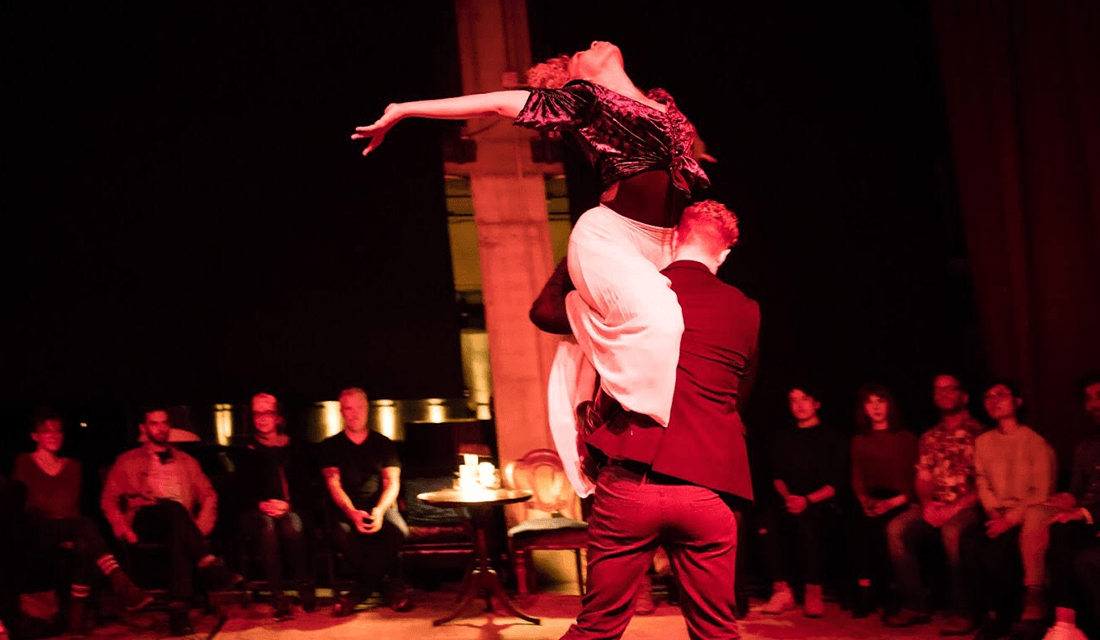
Mayte Natalio and Clinton Edwards in The Doubtful Guest | Source: Kyler Ross/LubDub Theatre Co.
Just presence alone becomes powerful in those moments.
There’s something powerful, too, in that we have the audience doing it to itself. So now you’re actually participating in that. And I think that’s powerful and, you know, by the end of the evening, we want everyone to be on the same level — but part way through [the show,] things are still settling and landing. By making sure that the audience is seeing each other — which are usually the last things to be seen as you go to see a show, is whoever sitting next to you [since] you’re always looking forward, not to your side — but to be able to turn the audience in on itself, I think, is really special.
Caitlin Cassidy
It’s all very authentic to the experience of séances. I think any good ritual — or any good performance, if they are different — is about being seen.
This is a great segue into the topic of séance, which is at the heart of The Doubtful Guest. Obviously, people have different kinds of connections or associations with séances.
How do you get people to buy into it for the show?
Caitlin Cassidy
We have to honor what the traditional turn-of-the-19th-century [American séance] was. But, at the same time, we are really interested in deconstructing and contemporizing — particularly in the context of theatre and theatre-making — what a séance would look like [today.]
Geoff Kanick
One of our leading questions was “what would a contemporary séance look like?” It becomes about [a] celebration of being together. We start by leaning into expectations, and then we completely subvert and move way, way back, slowly through the rest of the evening — so that we can all get to this place and this mutual understanding of what a “good séance” is.
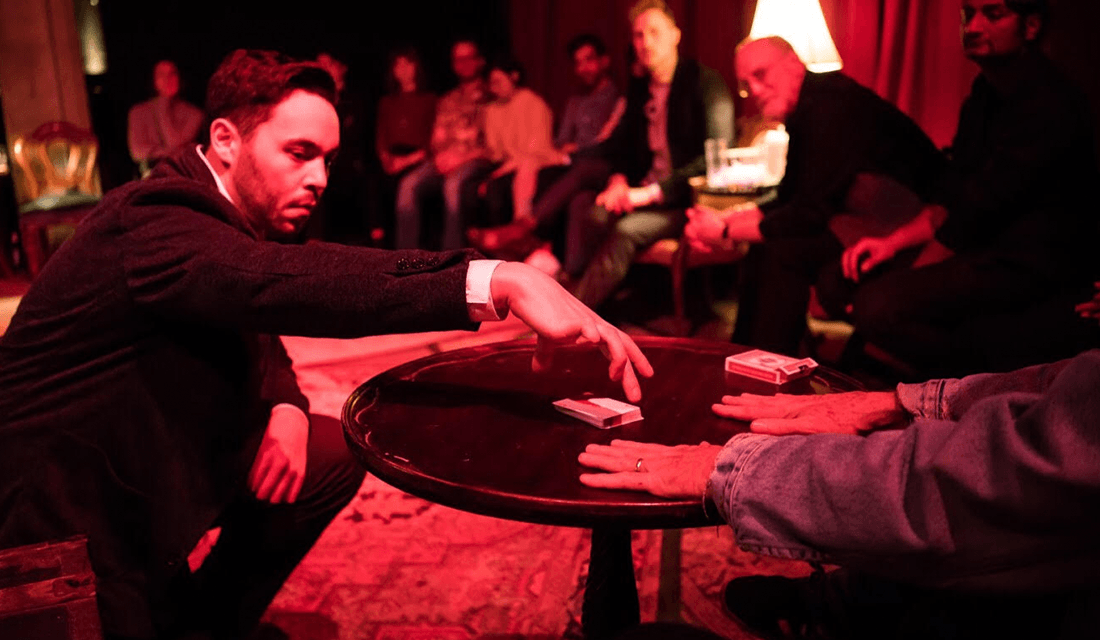
Geoff Kanick in The Doubtful Guest | Source: Kyler Ross/LubDub Theatre Co.
Caitlin Cassidy
The good séance [idea] came out of questions like “what it means to be a good host” and like “what it means to have people [come] over to your home” — which is what séances were [back then]. You’d advertise in newspapers and a bunch of strangers would show up, maybe some people you knew, to your living room.
Geoff Kanick
There’s an important twist that happens later in the show, which is [when] we change the idea of a séance to being about memory, and about remembering someone, and it becomes, I think, very inclusive to anyone’s beliefs or what they did bring with their expectations. It doesn’t have to be about afterlife; it doesn’t have to be about ghosts or spirits. It just has to be about the act of remembering.
You mentioned the show’s first iteration performed in your apartment. Now it has been performed inside the Public Hotel.
How has the show changed since then?
Caitlin Cassidy
I think it’s actually interesting to start with what hasn’t changed, and what hasn’t changed is our fascination with — obviously [influenced by] this moment of being alive — welcoming and hospitality, and what it means to bring people into your home, your most personal vulnerable space, which is often the setting for a lot of ghost stories.
Geoff Kanick
There was a great moment when someone, who came to the show at our apartment, said this wonderful thing, which was, “I don’t really remember much from two years ago, but I do remember what I ate in your apartment.” So food and being there became so specific, [as is] having some sort of hospitality and the sense of welcoming. I think at the heart of this whole piece, it’s always been about welcoming into a home and feeling like you are in a person’s living room.
What do you think is the future of the role of the audience, whether in your shows or in theatre in general?
Geoff Kanick
Theatre is, I think, so unique and so special because it happens live and it happens in one place. Unlike a movie, which I can watch on my couch at home on a big screen, or I can go to a movie theater, perhaps in any city, and see the same movie, there’s something special about [the fact that] this evening is live, and that we all have to come from somewhere to be here to witness it.
Earlier we talked about presence, and just being with people is, I think, really, really missing in a highly digital world, where social media is telling you that you’re close to people but you’re actually very far away from them. I think that creating theatre that can put people in the same room together to see each other, is something that I know we’re excited about making. And I think [it] can do a lot of good for people to see each other and be seen.
Notes left behind by the audience following a performance of The Doubtful Guest | Source: LubDub Theatre Co./Instagram
Caitlin Cassidy
I’ve been thinking a lot about theatre that kind of feels like a classroom. I don’t mean that in the sense of like we’re here to teach you something. It’s like the best kind of classroom, where you learn from whoever is in the room. So, if theatre could tap into that and really get us all present in the same room and talking to each other, or experiencing together, feeling together, moving together — that feels like where I’d like to be.
Geoff Kanick
And that doesn’t mean agreeing; that also means debate. That’s important as well. Giving a space for debate that allows for conversation after.
Thank you both so much for your time!
Editor’s Note: LubDub Theatre Company has previously employed Swedian as a graphic designer for the company in general and for The Doubtful Guest.
Caitlin Cassidy
She is an actor-singer-theatremaker based in NYC. Caitlin received her B.A. in Government and Arabic from Georgetown University and holds a master’s in Acting from East 15 in London. Caitlin is a 2017-18 Fellow with Georgetown University’s Laboratory for Global Performance and Politics and a 2017 Global Cultural Fellow with the University of Edinburgh’s Institute for International Cultural Relations. She has served as Language and Culture Fellow with AMIDEAST, has produced performance under the Tunisian Ministry of Education in Tunisia, designed and implemented theatre-based curricula in Saudi Arabia, and developed and performed work for the International Theatre Institute, UNESCO World Theatre Conference, and International Theatre Festival of Kerala, India. She is Founding Co-Artistic Director of LubDub Theatre Company. Acting credits include: Paradise (Central Square Theater), A Doll’s House (Epic Theatre Ensemble), Anything Goes (Williamstown Theatre Festival), Cymbeline (Shakespeare’s Globe Theatre, London), and Kafka’s Metamorphosis (Synetic Theatre Company). www.CaitlinNCassidy.com
Geoff Kanick
He is an actor-magician-theatre maker. Geoff has been performing professionally as a variety entertainer for over ten years, specializing in the vaudeville tradition and performing a unique blend of new circus, improvised comedy, physical theatre, and world-class illusion. Geoff graduated with distinction from the Master’s Program in International Acting at East 15 in London. He has also trained at Shakespeare’s Globe Theatre and at the London Dramatic Academy. He was named Seattle Performing Artist of the Year in 2012. Geoff has toured one-man shows across the country. He was an original cast member of Drama Desk award-winning Queen Of The Night at the Paramount in New York City’s Times Square, in which he starred as Sarastro and served as a member of the creative team. Most recently, Geoff served as Resident Director of Randy Weiner and Ryan Heffington’s immersive spectacle Seeing You. He is Founding Co-Artistic Director of LubDub Theatre Company. www.geoffkanick.com

